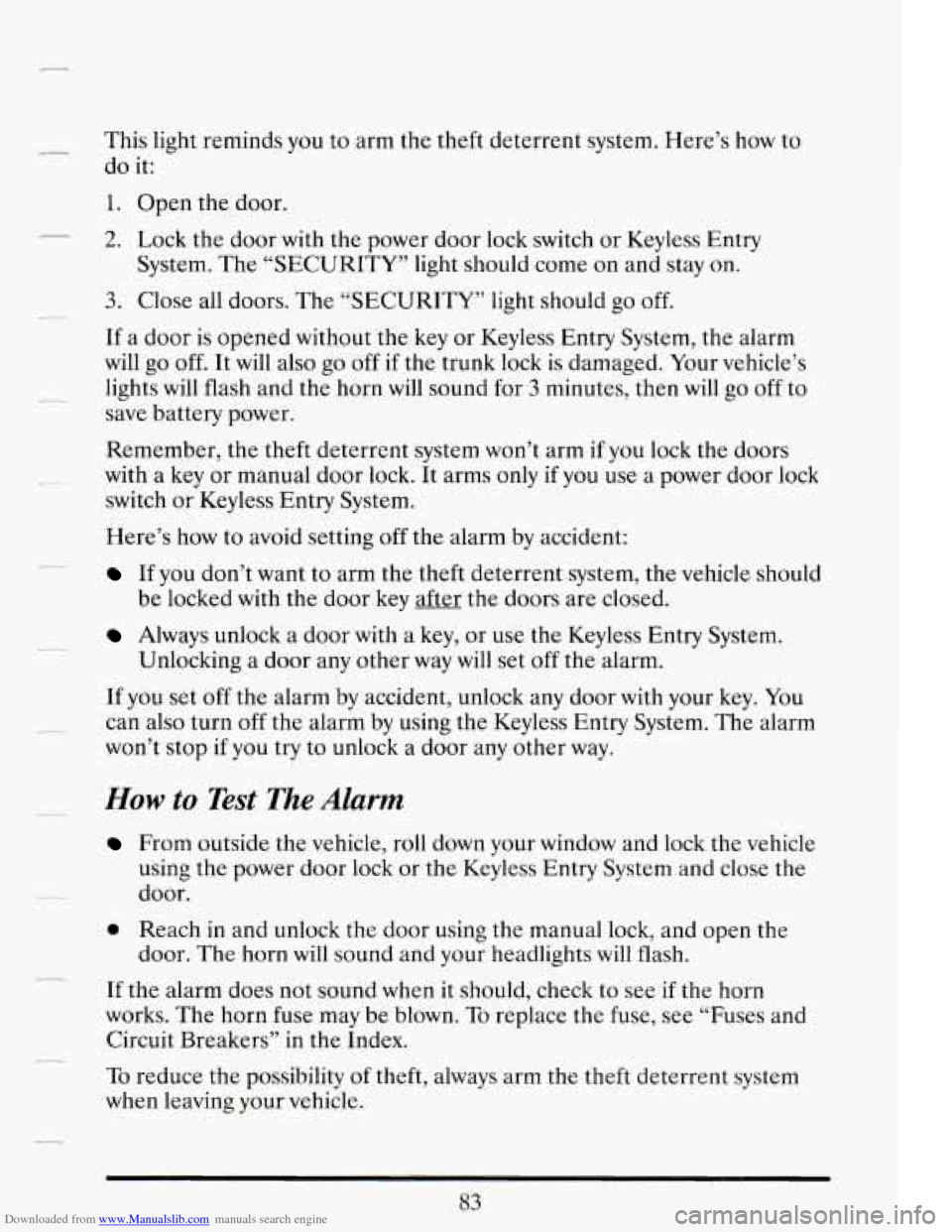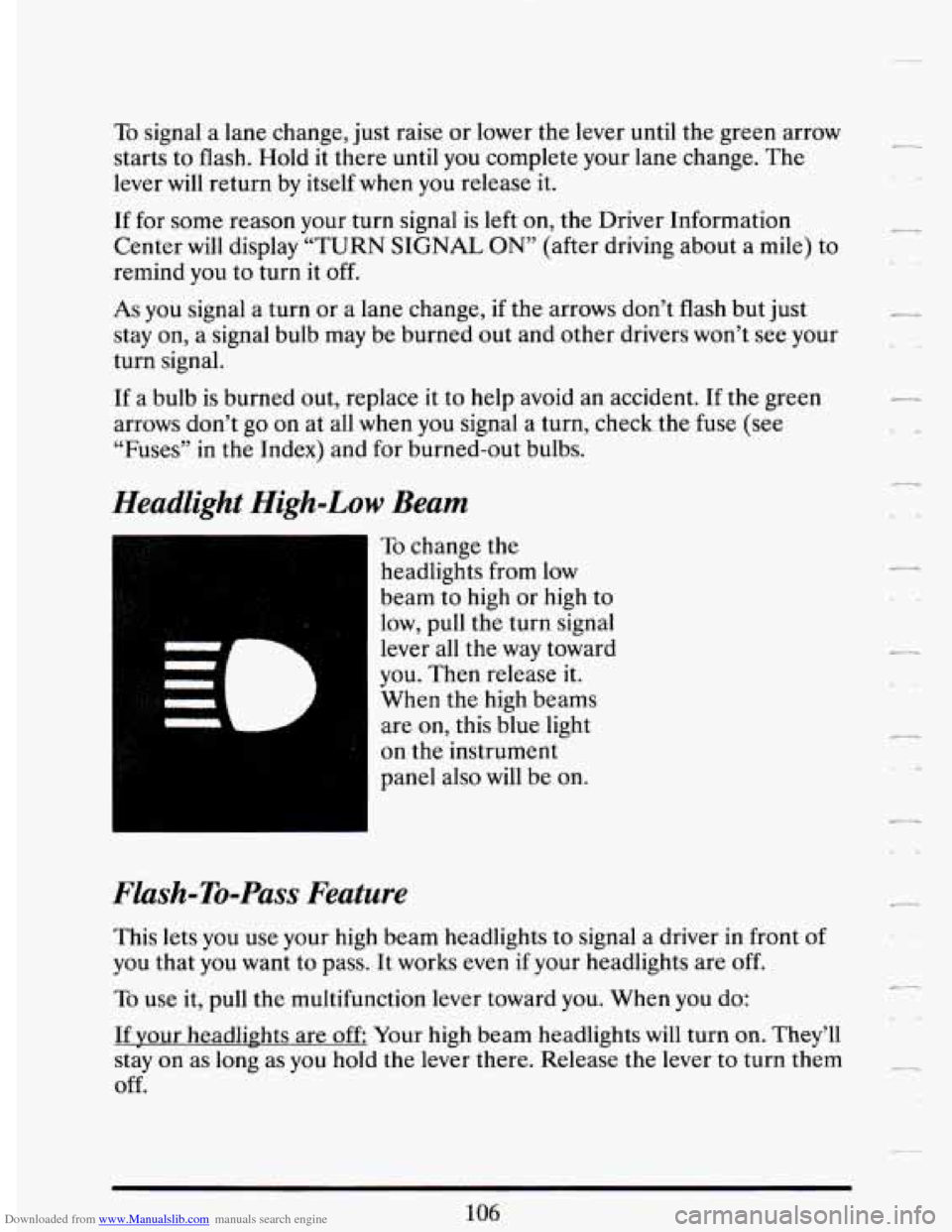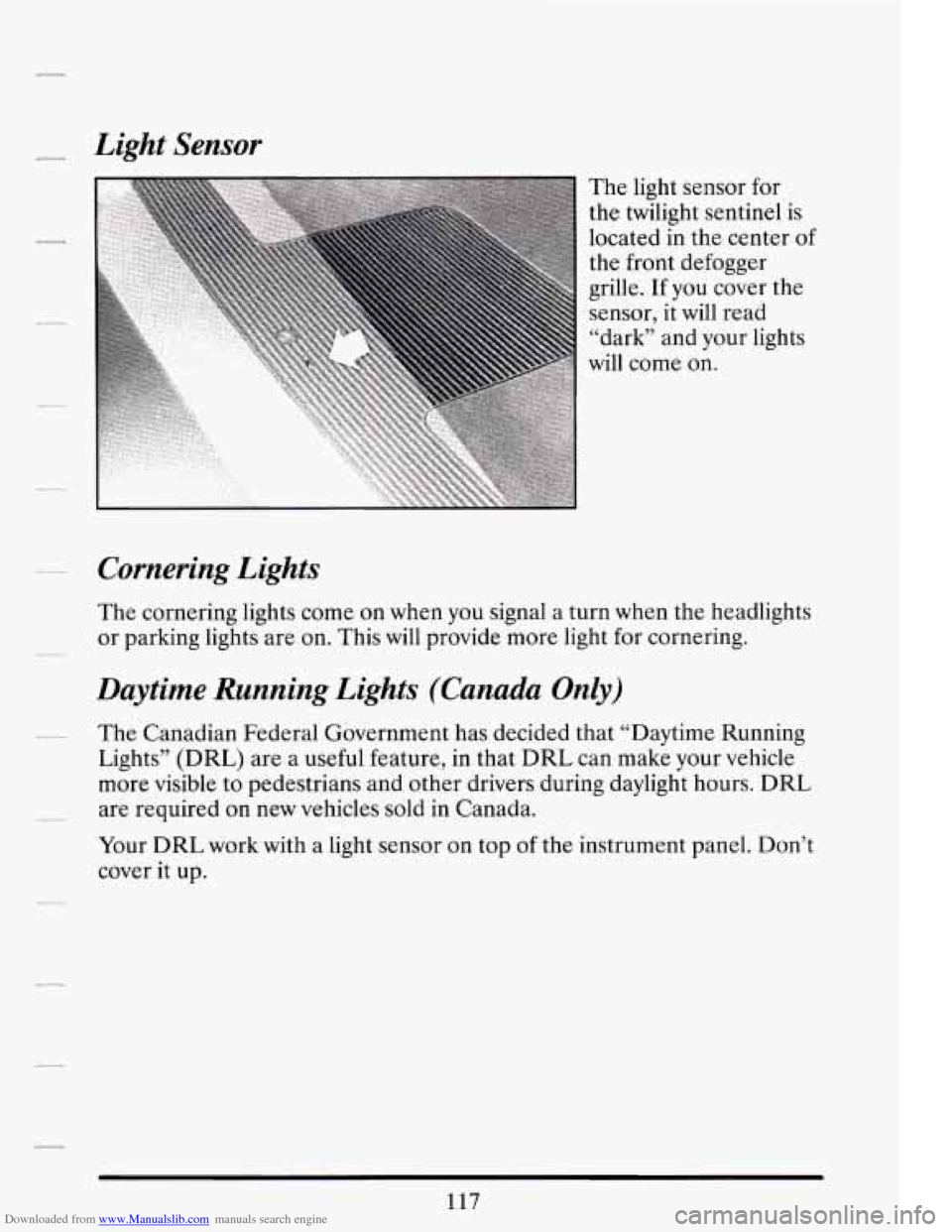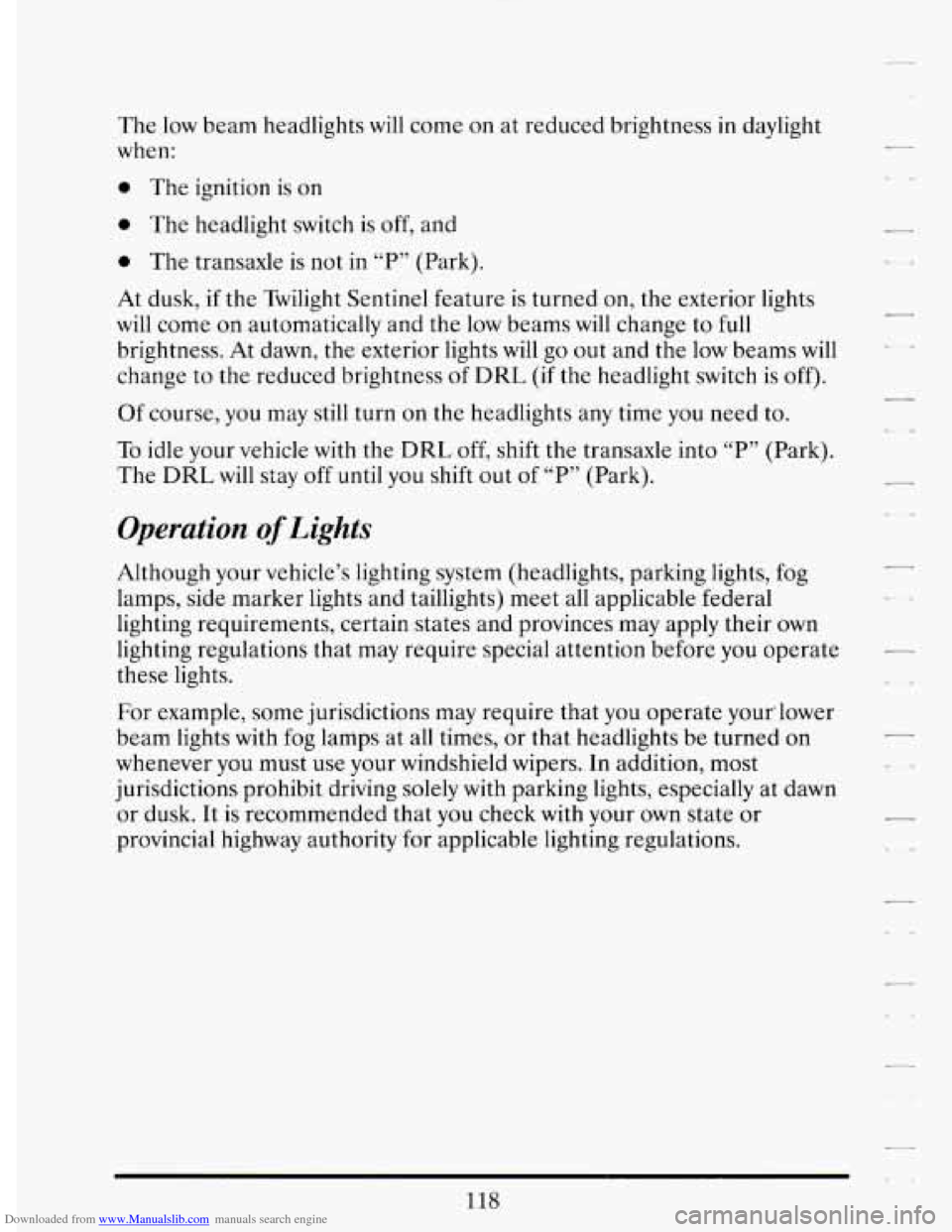headlights CADILLAC DEVILLE 1994 7.G Owners Manual
[x] Cancel search | Manufacturer: CADILLAC, Model Year: 1994, Model line: DEVILLE, Model: CADILLAC DEVILLE 1994 7.GPages: 399, PDF Size: 20.97 MB
Page 96 of 399

Downloaded from www.Manualslib.com manuals search engine This light reminds you to arm the theft deterrent system. Here’s how to
do it:
1. Open the door.
2. Lock the door with the power door lock switch or Keyless Entry
System. The “SECURITY” light should come
on and stay on.
3. Close all doors. The “SECURITY” light should go off.
If a door
is opened without the key or Keyless Entry System, the alarm
will go off. It
will also go off if the trunk lock is damaged. Your vehicle’s
lights will flash and the horn
will sound for 3 minutes, then will go off to
save battery power.
Remember, the theft deterrent system won’t arm
if you lock the doors
with a key or manual door lock. It arms only
if you use a power door lock
switch
or Keyless Entry System.
Here’s how to avoid setting
off the alarm by accident:
__ If you don’t want to arm the theft deterrent system, the vehicle should
be locked with the door
key after the doors are closed.
Always unlock a door with a key, or use the Keyless Entry System.
Unlocking a door any other way
will set off the alarm.
If you set off the alarm by accident, unlock any door with your key. You
can also turn
off the alarm by using the Keyless Entry System. The alarm
won’t stop
if you try to unlock a door any other way.
How to Test The Alarm
From outside the vehicle, roll down your window and lock the vehicle
using the power door lock or the Keyless
Entry System and close the
door.
door. The horn will sound and your headlights will flash.
0 Reach in and unlock the door using the manual lock, and open the
If the alarm does not sound when
it should, check to see if the horn
works. The horn fuse may be blown.
To replace the fuse, see “Fuses and
Circuit Breakers”
in the Index.
To reduce the possibility of theft, always arm the theft deterrent system
when leaving your vehicle.
83
Page 119 of 399

Downloaded from www.Manualslib.com manuals search engine To signal a lane change, just raise or lower the lever until the green arrow
starts to flash. Hold it there until you complete your lane change. The
lever will return by itself when
you release it.
If for some reason your turn signal is left on, the Driver Information
Center
will display “TURN SIGNAL ON” (after driving about a mile) to
remind you to turn
it off.
As you signal a turn or a lane change, if the arrows don’t flash but just
stay on,
a signal bulb may be burned out and other drivers won’t see your
turn signal.
If
a bulb is burned out, replace it to help avoid an accident. If the green
arrows don’t
go on at all when you signal a turn, check the fuse (see
“Fuses”
in the Index) and for burned-out bulbs.
Headlight High-Low Beam
I
To change the
headlights from
low
beam to high or high to
low, pull the turn signal
lever all the way toward
you. Then release it.
When the high beams
are on, this blue light
on the instrument
panel also will be
on.
Flash-To-Pass Feature
This lets you use your high beam headlights to signal a driver in front of
you that you want to pass. It works even if your headlights are
off.
To use it, pull the multifunction lever toward you. When you do:
If vour headlights are
off Your high beam headlights will turn on. They’ll
stay on as long as you hold the lever there. Release the lever to turn them
off.
106
Page 120 of 399

Downloaded from www.Manualslib.com manuals search engine If your headlights are on, but on low beam: The system works normally.
Just pull the lever. Your headlights will shift to high beam and stay there.
To return to low beam, just pull the lever toward you.
If your headlights are on? and on high beam: Your headlights will switch
to
low beam. To get back to high beam, pull the lever toward you.
Windshield Wipers
WIPER To control the wipers, turn the band on the multifuction lever.
MIST: Turn the band away from you and then release it for a single wipe
cycle. For more cycles,
hold the band on MIST longer.
LO or HI: Turn the band toward you to either LO (low speed) or to
HI (high speed), depending on the wiper speed you want.
DELAY: With this you can set the wiper speed for a long or short delay
between wipes. Move the band
to ON for long delays and the closer you
get to LO the shorter the delay.
OFF: To turn the wipers off, turn the band to OFF
107
Page 128 of 399

Downloaded from www.Manualslib.com manuals search engine LIGHTS
You’ll find the control on the left side of the instrument panel.
It controls these light systems:
Headlights
Taillights
0 Parking Lights
0 Instrument Panel Lights
License Plate Lights
0 Interior Courtesy Lights
. . .. I . ..< . , i ., . ,
Here’s how to
manually work your
light system.
Pull the switch out to the first stop to turn on your parking and
taillights, side marker lights and instrument panel lights.
0 Pull the switch out all the way to turn on the headlights.
You can brighten or dim your instrument cluster by rotating the
0 Push the switch all the way in to turn them off.
headlight switch.
Page 130 of 399

Downloaded from www.Manualslib.com manuals search engine - Light Sensor
Cornering Lights
The light sensor for
the twilight sentinel is
located
in the center of
the front defogger
grille. If
you cover the
sensor, it will read
“dark” and your lights
will come on.
The cornering lights come
on when you signal a turn when the headlights
or parking lights are on. This will provide more light for cornering.
Daytime Running Lights (Canada Only)
The Canadian Federal Government has decided that “Daytime Running
Lights”
(DRL) are a useful feature, in that DRL can make your vehicle
more visible to pedestrians and other drivers during daylight hours. DRL
are required on new vehicles sold in Canada.
Your DRL work with a light sensor on top
of the instrument panel. Don’t
cover it up.
117
Page 131 of 399

Downloaded from www.Manualslib.com manuals search engine The low beam headlights will come on at reduced brightness in daylight
0
0
0
A
when:
The ignition is on
The headlight switch is off, and
The transaxle is not in
“P” (Park).
.ts
,t
dusk,
if the Twilight Sentinel feature is turned on, the exterior ligh
will come on automatically and the low beams
will change to full
brightness. At dawn, the exterior lights will go out and the low beams will
..
change to the reduced brightness of DRL (if the headlight switch is off).
Of course, you may still turn on the headlights any time you need to.
To idle your vehicle with the DRL
off, shift the transaxle into “P” (Park).
The DRL will stay off until you shift out
of “P” (Park).
Operation of Lights
Although your vehicle’s lighting system (headlights, parking lights, fog
lamps, side marker lights and taillights) meet all applicable federal
lighting requirements, certain states and provinces may apply their own
lighting regulations that may require special attention before you operate
-
these lights.
For example, some jurisdictions may require that you operate your. lower
beam lights with fog lamps at all times, or that headlights be turned on
whenever you must use your windshield wipers.
In addition, most
jurisdictions prohibit driving solely with parking lights, especially at dawn
or dusk. It is recommended that you check with your own state
or
provincial highway authority for applicable lighting regulations.
118
Page 134 of 399

Downloaded from www.Manualslib.com manuals search engine MIRRORS
Automatic Inside And Outside Rearview Mirrors
Your Cadillac has an
inside automatic
electrochromic rearview mirror
This mirror automatically changes to reduce glare from headlights behind
you.
A photocell on the back of the mirror senses when it is becoming
dark outside. Another photocell built into the mirror surface senses the
headlights behind you.
The mirror will darken gradually to reduce glare. This change may take a
few seconds.
OnlOff Switch
121
Page 204 of 399

Downloaded from www.Manualslib.com manuals search engine While driving on a surface with reduced traction, try your best to avoid
sudden steering, acceleration, or braking (including engine braking by
shifting
to a lower gear). Any sudden changes could cause the tires to
slide. You may not realize the surface is slippery until
your vehicle is
skidding. Learn to recognize warning clues -- such as enough water, ice or
packed snow on the road to make a “mirrored surface”
-- and slow down
when you have any doubt.
Remember:
Any anti-lock braking system (ABS) helps avoid only the
braking skid.
DRn/lNG ATNIGHT
ia
Night driving is more dangerous than day driving. One reason is that
some drivers are
likely to be impaired -- by alcohol or drugs, with night
vision problems, or by fatigue.
Here are some tips on night driving.
Drive defensively.
0 Don’t drink and drive.
Adjust your inside rearview mirror to reduce the glare from headlights
Since you can’t see as well, you may need to slow down and keep more
behind
you.
space
between you and other vehicles.
191
Page 205 of 399

Downloaded from www.Manualslib.com manuals search engine Slow down, especially on higher speed roads. Your headlights can light
up only
so much road ahead.
0 In remote areas, watch for animals.
If you’re tired, pull off the road in a safe place and rest.
Night Vision
No one can see as well at night as in the daytime. But as we get older
these differences increase. A 50-year-old driver
may require at least twice
as much light to see the same thing at night as
a 20-year-old.
What you do in the daytime can also affect your night vision.
For
example, if you spend the day in bright sunshine you are wise to wear
sunglasses. Your eyes will have less trouble adjusting to night. But if
you’re driving,. don’t wear sunglasses at night. They may cut down on
glare from headlights, but they also make a lot
of things invisible.
You can be temporarily blinded by approaching lights. It can take a
second or two, or even several seconds, for your eyes to readjust to the
dark. When you are faced with severe glare (as from a driver who doesn’t
lower the high beams, or a vehicle with misaimed headlights), slow down
a little. Avoid staring directly into the approaching lights.
Keep your windshield and all the glass on your vehicle clean
-- inside and
out. Glare at night is made much worse by dirt on the glass. Even the
inside
of the glass can build up a film caused by dust. Dirty glass makes
lights dazzle and flash more than clean glass would, making the pupils
of
your eyes contract repeatedly.
Remember that your headlights light up far less
of a roadway when you
are in
a turn or curve. Keep your eyes moving; that way, it’s easier to pick
out dimly lighted objects. Just as your headlights should be checked
regularly for proper aim,
so should your eyes be examined regularly.
Some drivers suffer from night blindness
-- the inability to see in dim light
-- and aren’t even aware of it.
192
Page 208 of 399

Downloaded from www.Manualslib.com manuals search engine p_ Hydroplaning
Hydroplaning is dangerous. So much water can build up under your tires
that they can actually ride on the water. This can happen if the road is wet
enough and you’re going fast enough. When your vehicle is hydroplaning,
it has little or no contact with the road.
Hydroplaning doesn’t happen often. But
it can if your tires haven’t much
tread or if the pressure in one or more is low. It can happen
if a lot of
water is standing on the road. If you can see reflections from trees,
telephone poles, or other vehicles, and raindrops “dimple” the water’s
surface, there could be hydroplaning.
n
Hydroplaning usually happens at higher speeds. There just isn’t a hard
and fast rule about hydroplaning. The best advice is to slow down when it
-- is raining.
Some Other Rainy Weather Tips
Turn on your low-beam headlights -- not just your parking lights -- to
help make you more visible to others.
0 Besides slowing down, allow some extra following distance. And be
especially careful when you pass another vehicle. Allow yourself more
clear room ahead, and be prepared to have your
view restricted by
road spray.
0 Have good tires with proper tread depth. (See “Tires” in the Index.)
195